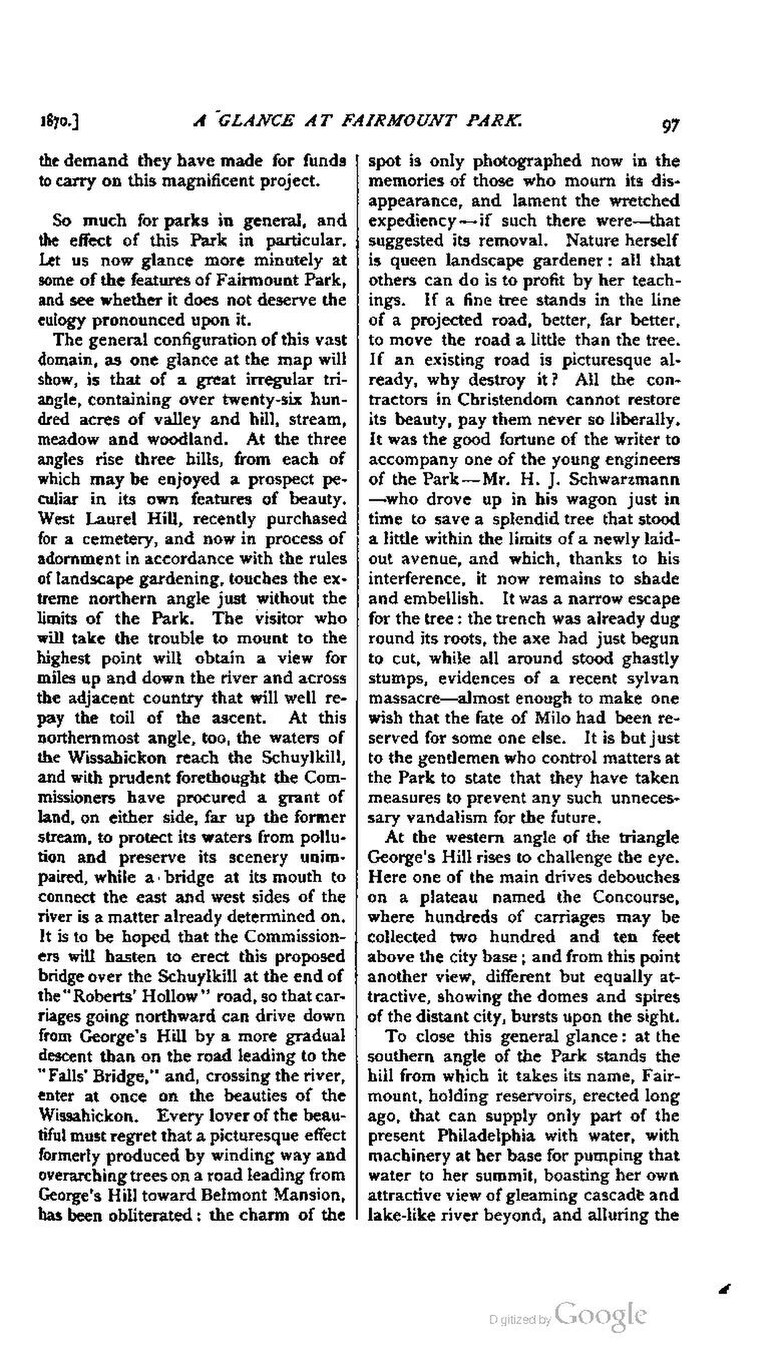the demand they have made for funds to carry on this magnificent project.
So much for parks in general, and the effect of this Park in particular. Let us now glance more minutely at some of the features of Fairmount Park, and see whether it does not deserve the eulogy pronounced upon it.
The general configuration of this vast domain, as one glance at the map will show, is that of a great irregular triangle, containing over twenty-six hundred acres of valley and hill, stream, meadow and woodland. At the three angles rise three hills, from each of which may be enjoyed a prospect peculiar in its own features of beauty. West Laurel Hill, recently purchased for a cemetery, and now in process of adornment in accordance with the rules of landscape gardening, touches the extreme northern angle just without the limits of the Park. The visitor who will take the trouble to mount to the highest point will obtain a view for miles up and down the river and across the adjacent country that will well repay the toil of the ascent. At this northernmost angle, too, the waters of the Wissahickon reach the Schuylkill, and with prudent forethought the Commissioners have procured a grant of land, on either side, far up the former stream, to protect its waters from pollution and preserve its scenery unimpaired, while a bridge at its mouth to connect the east and west sides of the river is a matter already determined on. It is to be hoped that the Commissioners will hasten to erect this proposed bridge over the Schuylkill at the end of the "Roberts' Hollow" road, so that carriages going northward can drive downfrom George's Hill by a more gradual descent than on the road leading to the "Falls' Bridge," and, crossing the river, enter at once on the beauties of the Wissahickon. Every lover of the beautiful must regret that a picturesque effect formerly produced by winding way and overarching trees on a road leading from George's Hill toward Belmont Mansion, has been obliterated: the charm of the spot is only photographed now in the memories of those who mourn its disappearance, and lament the wretched expediency—if such there were—that suggested its removal. Nature herself is queen landscape gardener: all that others can do is to profit by her teachings. If a fine tree stands in the line of a projected road, better, far better, to move the road a little than the tree. If an existing road is picturesque already, why destroy it? All the contractors in Christendom cannot restore its beauty, pay them never so liberally. It was the good fortune of the writer to accompany one of the young engineers of the Park—Mr. H. J. Schwarzmann—who drove up in his wagon just in time to save a splendid tree that stood a little within the limits of a newly laid-out avenue, and which, thanks to his interference, it now remains to shade and embellish. It was a narrow escape for the tree: the trench was already dug round its roots, the axe had just begun to cut, while all around stood ghastly stumps, evidences of a recent sylvan massacre—almost enough to make one wish that the fate of Milo had been reserved for some one else. It is but just to the gentlemen who control matters at the Park to state that they have taken measures to prevent any such unnecessary vandalism for the future.
At the western angle of the triangle George's Hill rises to challenge the eye. Here one of the main drives debouches on a plateau named the Concourse, where hundreds of carriages may be collected two hundred and ten feet above the city base; and from this point another view, different but equally attractive, showing the domes and spires of the distant city, bursts upon the sight.
To close this general glance: at the southern angle of the Park stands the hill from which it takes its name, Fairmount, holding reservoirs, erected long ago, that can supply only part of the present Philadelphia with water, with machinery at her base for pumping that water to her summit, boasting her own attractive view of gleaming cascade and lake-like river beyond, and alluring the
